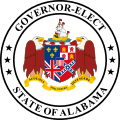Seals
States
- Seal of the governor-elect of Alabama [1]
- Seal of the lieutenant governor of Alabama [4]
- Seal of the governor of California [5]
- Seal of the governor of Connecticut [6]
- Seal of the lieutenant governor of Connecticut [7]
- Seal of the governor of Delaware [8]
- Seal of the governor of Maine [9]
- Seal of the governor of Massachusetts [10]
- Seal of the governor of Michigan [11]
- Seal of the governor of New Mexico
- Seal of the governor of North Carolina
- Seal of the governor of North Dakota
- Seal of the governor of Ohio
- Seal of the lieutenant governor of Ohio [12]
- Seal of the governor of Pennsylvania (official) [13]
- Seal of the governor of Pennsylvania (variant) [14]
- Seal of the governor of Rhode Island
- Seal of the lieutenant governor of Rhode Island
- Seal of the governor of South Carolina
- Seal of the lieutenant governor of South Carolina
- Seal of the governor of Texas [15]
- Seal of the lieutenant governor of Texas [16]
- Seal of the governor of Utah [17]
- Seal of the governor of Washington
- Seal of the lieutenant governor of Washington [18]
- Seal of the governor of West Virginia [19]
- Seal of the governor of Wyoming
Territories
- Seal of the Governor of Puerto Rico






























